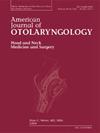特发性BPPV中维生素D缺乏与残留头晕之间的关系:耳石功能障碍和回归见解的重点
IF 1.7
4区 医学
Q2 OTORHINOLARYNGOLOGY
引用次数: 0
摘要
背景:特发性良性阵发性体位性眩晕(BPPV)患者成功进行管道复位手术(CRMs)后的持续性头晕(RD)是多因素的,维生素D (VD)缺乏可能影响耳石介导的前庭通路。目的探讨VD缺乏严重程度对RD发病率和前庭功能障碍的影响,评价补充VD对前庭功能障碍的影响。方法采用横断面研究方法,纳入138例不同VD水平的特发性BPPV患者。参与者按缺陷严重程度分层:正常(20 ng/mL)、不全(10 - 20 ng/mL)和缺陷(10 ng/mL)。记录RD危险因素(性别、年龄、CRMs次数、累及半规管)。耳石功能通过颈/眼前庭诱发肌生成电位(cemp /oVEMP)评估,前庭功能通过双热热测试评估。在crm后1周使用头晕障碍量表(DHI)测量RD严重程度。一个缺乏/不足的亚组(n = 30)接受为期12周的VD3补充(0.25 μg口服骨化三醇,每日两次)。结果:血清VD与DHI评分呈中度正相关(r = 0.365, P <;0.001)。cemp异常是唯一与RD相关的耳石参数(χ2 = 9.75, P = 0.002)。VD缺乏程度、cVEMP和年龄是RD的重要预测因素。治疗组VD水平在治疗前后显著升高(13.29±2.99∶23.24±4.78,P = 0.00)。3个月后,两组的cemp N23波潜伏期均显著缩短(P = 0.01和P = 0.02),但只有治疗组的oVEMP N10波潜伏期显著缩短(P = 0.01), DHI评分降低48.2% (P = 0.008)。结论VD可增强耳石功能和神经完整性。cemp、年龄和VD水平预测RD的可能性。这项研究首次表明补充VD可以改善囊功能和传递途径。本文章由计算机程序翻译,如有差异,请以英文原文为准。
Association between vitamin D deficiency and residual dizziness in idiopathic BPPV: Focus on otolith dysfunction and regression insights
Background
Residual dizziness (RD) following successful canalith repositioning maneuvers (CRMs) in idiopathic benign paroxysmal positional vertigo (BPPV) is multifactorial, with vitamin D (VD) deficiency hypothesized to influence otolith-mediated vestibular pathways.
Objective
To determine the impact of VD deficiency severity on RD incidence and vestibular dysfunction, and to evaluate the effects of VD supplementation on vestibular dysfunction.
Methods
A cross-sectional study enrolled 138 idiopathic BPPV patients with different VD level. Participants were stratified by deficiency severity: normal (>20 ng/mL), insufficiency (10–20 ng/mL), and deficiency (<10 ng/mL). RD risk factors (gender, age, times of CRMs, involved semicircular canals) were recorded. Otolith function was assessed via cervical/ocular vestibular-evoked myogenic potentials (cVEMP/oVEMP), and vestibular function via bithermal caloric testing. RD severity was measured using the Dizziness Handicap Inventory (DHI) at 1 week post-CRM. A subgroup (n = 30) with deficiency/insufficiency received 12-week VD3 supplementation (0.25 μg of oral calcitriol twice daily). Binary regression analysis was used to analyze predictors of RD.
Results: A moderate positive correlation emerged between serum VD and DHI scores (r = 0.365, P < 0.001). cVEMP abnormalities were the only otolith parameter associated with RD (χ2 = 9.75, P = 0.002). The degree of VD deficiency, cVEMP, and age emerged as significant predictors of RD. There was a significant increase in VD levels before and after treatment (13.29 ± 2.99 vs. 23.24 ± 4.78, P = 0.00) in the treatment group. Both groups showed significant shortening of cVEMP N23 wave latency after three months (P = 0.01 and P = 0.02), but only the treatment group showed significant reduction in oVEMP N10 wave latency (P = 0.01), with DHI scores reduced by 48.2 % (P = 0.008).
Conclusions
We confirmed that VD enhances otolith function and neural integrity. CVEMP, age, and VD levels predict RD likelihood. This research is the first to show VD supplementation improves saccule function and transmission pathways.
求助全文
通过发布文献求助,成功后即可免费获取论文全文。
去求助
来源期刊

American Journal of Otolaryngology
医学-耳鼻喉科学
CiteScore
4.40
自引率
4.00%
发文量
378
审稿时长
41 days
期刊介绍:
Be fully informed about developments in otology, neurotology, audiology, rhinology, allergy, laryngology, speech science, bronchoesophagology, facial plastic surgery, and head and neck surgery. Featured sections include original contributions, grand rounds, current reviews, case reports and socioeconomics.
 求助内容:
求助内容: 应助结果提醒方式:
应助结果提醒方式:


